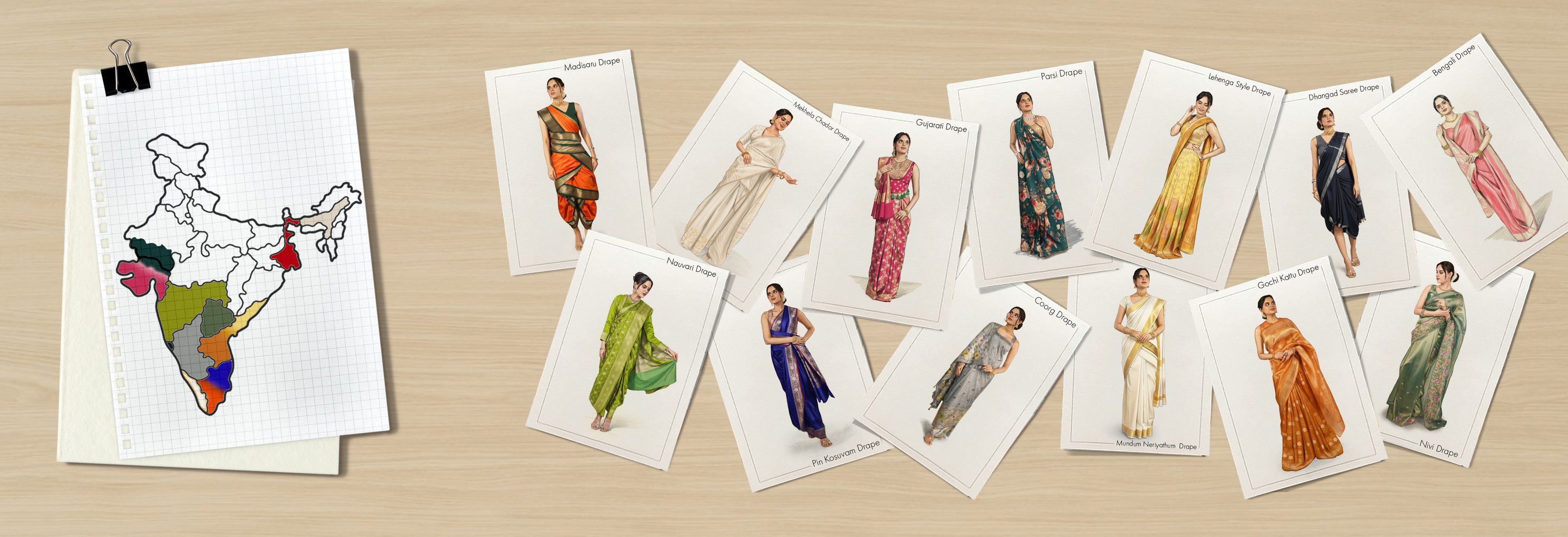Saree draping is an art of arranging and wearing the saree, which is a long piece of unstitched fabric, usually 6 yards and goes up to 9 yards, around the body. It involves wrapping the fabric around the waist till the feet, creating pleats in the centre below the navel, and draping the pallu (the decorative end) over the shoulder, securing it with pins.
The saree draping industry has become popular in the modern fashion world with over 500 draping styles. Traditionally there are 21+ saree draping styles but modern drape artists can style your saree in 350+ ways. Before all these came into existence, the traditional style of saree draping was already popular. Like the marathi drape, the south indian drape, the bengali style of saree draping, the gujarati drape and more.
Let us look at some of the classical saree draping styles that look royal, worn during cultural fests, festivities like Onam, Ganesh Chaturthi, Durga Puja and are never out of fashion.
Different Types Of Saree Draping
-
Nivi Drape:
This is the most popular drape from Andhra Pradesh. It involves tucking one end of the saree into the petticoat at the waist, wrapping it around, and then creating pleats to bring the pallu over the left shoulder.

-
Gujarati Drape (Seedha Pallu):
Another common saree draping style, the seedha pallu drape, here the pallu is brought forward from the back and spread across the chest before being draped over the right shoulder.

-
Mundum Neriyathum Saree Drape from Kerala:
The Mundum Neriyathum, as the name suggests, is a two-piece ensemble. The mundu is the lower garment draped around the waist, while the neriyathum is the upper garment, worn over a blouse diagonally from the right hip to the left shoulder. Traditionally, it is white or cream with a colored border, symbolizing purity and simplicity.

-
Bengali Drape:
Known for its unique pleats and pallu arrangement, it involves tucking the saree at the waist, creating 7-8 pleats at the front, and draping the long pallu. It is one of the most loved saree styles in north and east India.

-
Dhangad Saree Drape :
This saree is worn without a petticoat. It starts with a knot at the waist, followed by pleating like the basic drape, with the pallu over the left shoulder. The lower half is then taken between the legs to the back, giving it a dhoti-style appearance, and tucked at the waist in front. For ease of movement, some women tuck the saree at both sides of the waist and shorten the length to knee-level, perfect for daily chores and fieldwork.

-
Nauvari Saree Drape:
A traditional Maharashtrian drape, the Nauvari saree is a nine yard marvel draped in a way that resembles a dhoti, allowing for easy movement and functionality.

-
Coorg Drape:
The pallu is brought from the back to the front and pinned over the right shoulder. This is a distinctive style draping in Coorg, Karnataka.

-
Gochi kattu Drape:
From the Telangana region of Andhra Pradesh, this is a traditional draping style worn by the women of ‘Golla Shepherd’ and ‘Gudati Kapulu’ communities. This style involves a double knot at waist, tucking the other end between the leg and draping the rest of the fabric around the body.

-
Assamese Drape (Makela Sador):
This is a two piece garment consisting of a skirt (Makela) and a draped cloth (Sador), it is not a single saree draped in traditional Indian fashion but gives the illusion of a single saree drape.

-
Madisaru Saree Drape from Tamil Nadu:
The drapes come in two styles: the Iyer and the Iyengar kattu (tie). This saree is draped using a 9 yard fabric, much like the Nauvari sarees.

-
Lehenga Saree Drape:
Lehenga saree drape is a modern twist to the traditional saree draping style. This style combines the elegance of a saree with the volume and silhouette of a traditional lehenga.
-
The Pinkosu or Pin Kosuvam drape:
A traditional Tamil Nadu style of saree draping where the pleats are made and tucked to the back, rather than the front, allowing for greater freedom of movement.
-
Parsi Saree Drape:
Also known as Gol saree, this style drapes the pallu from back to front over the right shoulder, then diagonally across to the left—similar to the Seedha Pallu drape. It is a graceful style worn not only in India but also by the global Parsi community.
 End Note: Saree draping is an art that our Indian culture has preserved for centuries. Even with new designers and stylists doing the innovative drapes, the traditional saree draping remain timeless. They continue to be worn with love and pride during festivals and celebrations, ensuring they are never forgotten.
End Note: Saree draping is an art that our Indian culture has preserved for centuries. Even with new designers and stylists doing the innovative drapes, the traditional saree draping remain timeless. They continue to be worn with love and pride during festivals and celebrations, ensuring they are never forgotten.
At Tajore, we honor this heritage with our handmade saree collections, from Banarasi and Bandhani to Kalamkari and beyond, each representing the diverse traditions of India. Check our website tajore.com for more information or you can book an appointment with us for an exclusive store visit.





